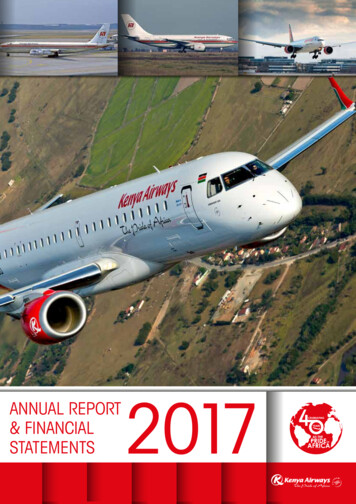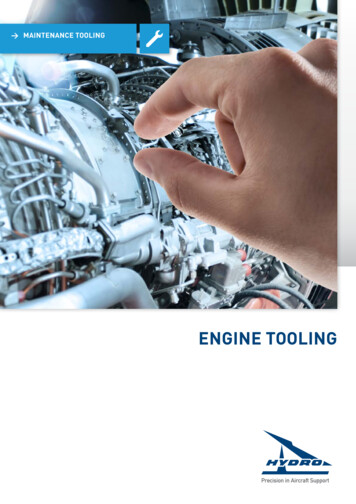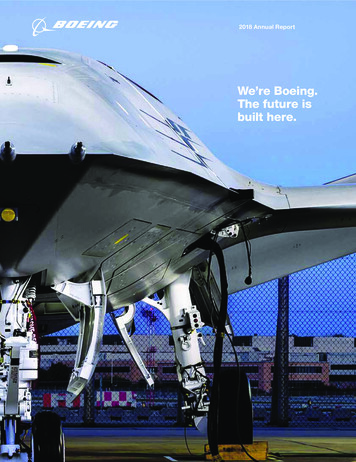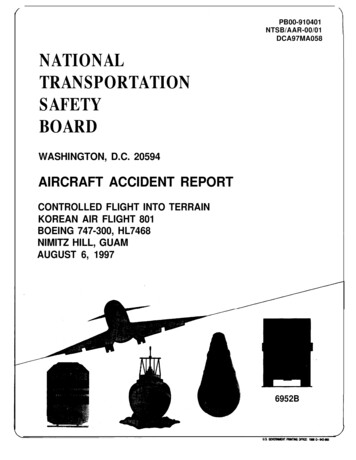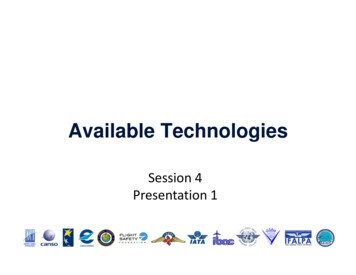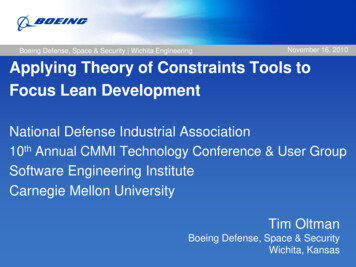
Transcription
Boeing SafetyManagementOverviewECCN: 9E991Copyright 2013 Boeing. All rights reserved.Doug KihmTechnical Fellow, Systems EngineeringBoeing Commercial AirplanesOctober 25, 2013
Agenda Boeing Aviation Safety Overview Boeing Participation in FAA Design &Manufacturing SMS Pilot Project Boeing Repair Station SMS Implementation Key MessagesCopyright 2013 Boeing. All rights reserved.ECCN: 9E9912
Boeing safety leadershipWorking together for a safe, efficient global systemPromote worldwide safety cultureCooperationAligned focusAssurehealthy safetyfoundationPromote proactiverisk managementData drivenKnowledgesharingDESIGN BUILD OPERATION MAINTENANCE INFRASTRUCTURE REGULATIONSafety Integration Across the Value StreamCopyright 2013 Boeing. All rights reserved.ECCN: 9E9913
Boeing works collaboratively and at a productlevel to make sure flying is as safe as possibleBoeing works together with others to makesure flying is as safe as possibleBoeing Regional Aviation Safety InitiativesEurope 8 Support ECAST safety activities Support RASG-EUR7ICAO Participate in ICAO safety activities Support ISSG and GASR update Support Global RunwaySafety InitiativeAviation safety is the combined result of: Regulatory oversightHow airplanes are designed and producedHow crews operate and maintain themHow air traffic and airport infrastructure support them3CIS Support RASG-EUR36US Support US CAST/ASIAS safetyinitiatives872Asia Pacific SupportRASG-APACand RAST-APAC64Commercial AviationSafety Team (CAST)An example ofcollaboration14Middle East Support RASG-MEand RAST-ME55OperatorsManufacturersGovernmentLatin America Support RASG-PAand RAST-PA1Africa Support RASG-AFI and RAST-AFICopyright 2013 Boeing. All rights reserved.5ECCN: 9E991Copyright 2013 Boeing. All rights reserved.6ECCN: 9E991Boeing Uses Robust Processes to Produce Safe ProductsBoeing continuously monitors performance of worldwide fleetAirplane-Level Safety AssessmentIn-Service Safety ProcessConfiguration FirmSelection ConceptProgramLaunchPDRFirmConfiguration CDRCertificationFirstFirstDeliveryFlightStart lineConceptDevelopmentJoint DefinitionDefineThreatsPASAFlight TestBuildFHA – FunctionalHazard AssessmentFMEA – Failure Mode& Effects AnalysisFTA – Fault TreeAnalysisCommon Cause AnalysisDefineSeparationRequirementsSystem FHAPreliminaryParticular RiskAssessmentPreliminaryFTAPASA – PreliminaryAirplane SafetyAssessmentCopyright 20112013 Boeing. All rights reserved.Copyright 2013 Boeing. All rights reserved.EngineeringSafetyReviewAirplane SafetyAssessmentFTAFinal ParticularRisk AssessmentFAA actionSupportZonalAnalysisCommon Mode &Resource AssuranceAnalysisAccident DataIncident DataOtherIn-Service EventsOperator ReportsFlight TestSuppliers ageFMEAHardwareSoftwareMechanical SystemsECCN: 9E991Issue resolution(corrective action)FAA engagementDetail Design &ReleaseDatasourcesAirplane FHAIssue classification(safety decision)ADsServiceLettersFleet TeamXChangeOperatorreports7Copyright 2013 Boeing. All rights reserved.* Continued Operational Safety ProgramECCN: 9E99184
Boeing’s Participation in FAA Design andManufacturing (D&M) SMS Pilot Project Boeing used a certificate-based organizational approach toconduct SMS gap analyses– Pilot Project focused on Type and Production Certificates,but considered potential impact on other Boeing CertificatesFAA D&M SMS Pilot ProjectTypeCertificateProductionCertificateRepair StationCertificateContinuedAirworthinessFlight TrainingCertificateFAA D&M SMSPilot GapAnalysisOtherCertificates/OrganizationsSafety Policy& ObjectivesSafety RiskManagementSafetyAssuranceSafetyPromotion(31) FAA Criteria(SM ICG (52) Criteria)(9) FAA Criteria(SM ICG (28) Criteria)(17) FAA Criteria(SM ICG (20) Criteria)(4) FAA Criteria(SM ICG (19) Criteria)Copyright 2013 Boeing. All rights reserved.ECCN: 9E9915
Boeing’s Organizational Management ProcessOrganizationOperationalProcedures &ChangeManagement Design Processes ice Manufacturing /Quality Processes Facilities Business Processes D&M organizational process and procedures designed to produce a compliant,conformed product Changes to organizational processes or procedures require validation that they will still produce acompliance, conformed product Data sources (in-service etc.) are used to identify organizational issues requiring corrective action toproduce a compliant, conformed product6Copyright 2013 Boeing. All rights reserved.ECCN: 9E991
Boeing Learning’s from FAA D&M SMS Pilot Project Annex 19 has addressed the issue of equivalency or reciprocalrecognition of SMS by different authorities for D&M made acceptable to the State of design or manufacture Need consistent evaluation criteria (gap analysis) to allow for efficientSMS implementation for large organizations with multiple aviationproducts and services Scope and treatment of organizational hazards needs to account forexisting design and manufacturing certification processes D&M sector specific guidance material is needed D&M relevant SMS safety performance indicators are needed Knowledge and experience from the D&M industry should be used tohelp develop sector specific guidance and policy Need to address readiness of regulatory oversightCopyright 2013 Boeing. All rights reserved.ECCN: 9E9917
Boeing Repair StationSafety Management System (SMS) DevelopmentSCM&O Regulatory & Quality System Oversight Boeing Repair Station is required to develop/deploy an SMS to satisfycurrent/future Civil Aviation Authorities (CAA) regulations: Bermuda Department of Civil Aviation (BDCA); timeline established for U.S. certifiedRepair Station (January 2013) Japan Civil Aviation Bureau (JCAB) in support of recertification audit (March 2013) Civil Aviation Administration of China (CAAC); foreign Repair Station application (ECD2014) Brazilian National Civil Aviation Agency (ANAC) in support of a change in regulations(ECD 2014) Australian Civil Aviation Safety Authority (CASA) in support of new regulations (ECDTBD) Federal Aviation Administration (FAA) and European Aviation Safety Agency (EASA);timelines not currently defined (ECD TBD) Boeing Repair Station conducted gap analysis using ICAO SMM and availableguidance material to satisfy BDCA, JCAB, and CASA regulations(requirements/expectations)COPYRIGHT 2009 THE BOEING COMPANY8
Boeing Repair StationSMS Development -- Various differencesSCM&O Regulatory & Quality System Oversight Various differences between ICAO SMM and BDCA, JCAB, and CASArequirements/expectations 46 differences between ICAO, BDCA, JCAB, and CASACOPYRIGHT 2009 THE BOEING COMPANY9
Safety Management SystemReliance on Quality Management System (QMS)SCM&O Regulatory & Quality System Oversight Boeing’s Repair Station SMS utilizes Quality Management System (QMS) QMS monitors for discrepancies Safety discrepancies dealt with via the SMS and quality discrepancies dealtwith via the QMS system SMS re-enforces the safety-just culture to encourage voluntary andconfidential discrepancy reporting For compliance purposes Boeing’s Repair Station SMS “manual” isseparate from it QMS manual Single SMS “manual” used to satisfy all regulatory standardsCOPYRIGHT 2009 THE BOEING COMPANY10
Boeing Repair StationSMS Development -- Lessons LearnedSCM&O Regulatory & Quality System Oversight Need management commitment Need to develop Subject Matter Experts (SMEs) to support SMSimplementation, deployment, and maintenance efforts Numerous external training providers -- need consistency Benefit from internal training developed -- emphasize organization’s uniqueconsiderations Utilize an approach to maximize safety enhancement Need one acceptable standard for all authorities Use existing processes, systems, and tools as much as possible Use the knowledge of others (e.g., internal/external benchmarking) Keep it simple – practical applicationCOPYRIGHT 2009 THE BOEING COMPANY11
Boeing Safety ManagementKey Messages Need one acceptable standard for all authorities Need ICAO and other aviation regulatory authorities to promote overallinternational regulatory harmonization Leverage reciprocal agreements to minimize administrative activitiesthat do not provide a commensurate safety benefit Need to involve industry in development of safety performanceindicators that are relevant to sector specific products orservices Authorities need to be ready for SMS oversightBoeing will remain engaged in the development and evolutionof aviation sector-specific safety management best practicesCopyright 2013 Boeing. All rights reserved.ECCN: 9E99112
Thank YouQuestions?Copyright 2013 Boeing. All rights reserved.ECCN: 9E991
Safety discrepancies dealt with via the SMS and quality discrepancies dealt with via the QMS system SMS re-enforces the safety-just culture to encourage voluntary and confidential discrepancy reporting For compliance purposes Boeing's Repair Station SMS "manual" is separate from it QMS manual Single SMS "manual" used to satisfy all .
